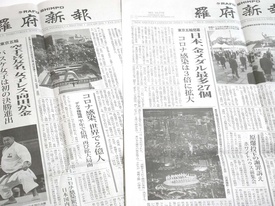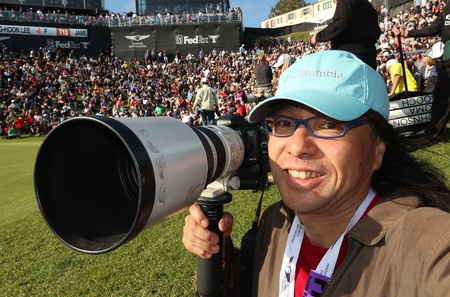Both English and Japanese
The Rafu Shimpo, first published in 1903, is still published four days a week as a paid paper (three days a week during the pandemic). Since the days before free papers, the paper has provided local news, Japanese news, and lifestyle information for the Japanese community in Los Angeles, and I have been relying on it since I moved to the United States. In this place where you can't go anywhere without a car, an acquaintance who has lived in Los Angeles for a long time gave me a copy of the Rafu Shimpo and said, "You can find a car on the classifieds." I still remember seeing an advertisement for a used car dealer and making an inquiry from a public phone. This was 29 years ago, before there were cell phones. And I was able to successfully purchase that bright red used Mazda.
Currently, the Rafu Shimpo has 10 pages, about 8,000 mail subscribers, and about 3,000 digital subscribers. Nagata Jun, who has been with the company for 21 years and has been the editor-in-chief of the Japanese section since 2020, explained the history of the paper. "The Rafu Shimpo was founded in 1903 by three students studying at USC (University of Southern California) from Japan. At a time when there was no Japanese media, it was founded to deliver information in Japanese to the Japanese community. Since it was the first generation at the time, the pages were all in Japanese. Later, as the second generation grew, an English section was established in 1926. We are now in the fifth generation, but the paper continues with both an English and Japanese section."
The first page of the Japanese section is a news article, and the second page is a community page with original reporting. Before the pandemic, there were constant requests to cover events, so Nagata and two other reporters went around to cover them. The fact that they received requests for coverage was proof that the magazine was being read by people, but Nagata said, "We need to strengthen the originality of our magazine through original reporting so that the community feels that it is more important."
He says that one idea for emphasizing originality is to convey the current situation and efforts of the Japanese American community in Japanese. "The Japanese American community in Los Angeles is divided into the Japanese American community and the Japanese-speaking community. While the organizations of the Japanese-speaking community are social groups, Japanese Americans have created well-run organizations such as the Japanese American National Museum and the Japanese American Cultural and Community Center, which employ professional staff to run them. I feel a sense of mission to translate these efforts of Japanese Americans into Japanese and convey them to readers whose first language is Japanese. There is a lot we Japanese can learn from Japanese Americans, and I want people to know more about their society."
Another issue facing the Japanese section is how to stop the decline in subscribers and turn it around to an increase. "Subscribing to the newspaper itself is expensive because of the postage costs, and it takes time for the newspaper to arrive in the hands of subscribers, which is the day after publication. However, with the online version, you can read it immediately, and there are no postage costs, so the monthly subscription fee is $50."
Promoting online access is a way forward
The future looks bright if the number of digital subscribers can grow to far exceed that of newspaper subscribers. In addition, the company is also working on a project to develop more online-only content in addition to the digital edition.
"We revamped the design of our website in mid-July. Going forward, we will be enhancing the site's original content. Our aim is to feature original stories and use them as a selling point to attract more advertising on the site."
Nagata, who joined The Rafu Shimpo in 2000, looked back on his reasons for going to America and how he ended up joining the company as follows: "I had always admired America, so after graduating from a Japanese university, I came here to study English at an English school. I thought I would return to Japan after a little over a year, but then I found out there was a way to transfer to a community college, and majored in business administration. I was issued an OPT (optional training) visa, so I wanted to gain experience in America and started looking for work at a Japanese company, but I didn't have much luck. So I submitted a photo I liked to a photo contest run by The Rafu Shimpo, and it was selected, so I went to collect the prize (from The Rafu Shimpo). Then, a company heard that I was looking for work, and I was hired. At first, I started by making negatives for the English section of the paper. Later, when digitalization took over my job, I lost my job, so I was transferred to the Japanese section and became a reporter. The company sponsored me for a professional visa and permanent residency, and I'm here today."
We asked him about the rewards of working for a long-established Japanese newspaper in Los Angeles. "Because we deliver articles in Japanese, I get the feeling that Japanese society appreciates them. I've also met a lot of people through this job, which is a great asset. Also, the Rafu Shimpo was my first time writing as a job, and I recognize the importance of being responsible for the articles that are delivered to people. Our mission is to convey only the truth, and fake news, as people have been saying lately, is not acceptable. I learned about the sense of responsibility of a news medium from the attitudes of the previous editors-in-chief, Nagashima-san and Ishihara-san. Also, I don't think that this job is about working for yourself, but rather working for the readers to whom you deliver information."
It is my sincere hope that the newspaper will attract more digital readers in the future and preserve the traditional brand name of The Rafu Shimpo.
The Rafu Shimpo official website: https://rafu.com/ja
© 2021 Keiko Fukuda








